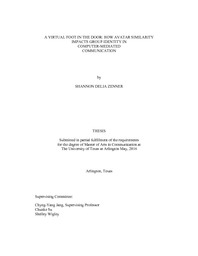
ATTENTION: The works hosted here are being migrated to a new repository that will consolidate resources, improve discoverability, and better show UTA's research impact on the global community. We will update authors as the migration progresses. Please see MavMatrix for more information.
Show simple item record
| dc.contributor.advisor | Jang, Chyng-Yang | |
| dc.creator | Zenner, Shannon | |
| dc.date.accessioned | 2016-09-28T17:54:00Z | |
| dc.date.available | 2016-09-28T17:54:00Z | |
| dc.date.created | 2016-05 | |
| dc.date.issued | 2016-05-16 | |
| dc.date.submitted | May 2016 | |
| dc.identifier.uri | http://hdl.handle.net/10106/25892 | |
| dc.description.abstract | Communication researchers continue to explore the promise and the
impact of the Internet and computer-mediated communication. While much
research has shown that the effects have been distancing, polarizing and negative others point to a more connected global world. In this study we attempt to look for the initial promise of the Internet. By manipulating anonymity, avatars and types of similarity in a virtual computer-mediated scenario we uncover a pathway to improve group identity, trust and social attraction. These concepts are supported by social identity theories and by the social identity model of deindividuation effects (SIDE). A 2x3 factorial experimental design looked for causal relationships but all the findings did not support our hypotheses. However, we did support our underlying suppositions and the basis for our conceptual model. | |
| dc.format.mimetype | application/pdf | |
| dc.language.iso | en_US | |
| dc.subject | Avatar | |
| dc.subject | SIDE | |
| dc.subject | Social identity | |
| dc.subject | Similarity | |
| dc.subject | CMC | |
| dc.subject | Group identity | |
| dc.subject | Trust | |
| dc.subject | Social attraction | |
| dc.subject | Competition | |
| dc.title | A Virtual Foot in the Door: How Avatar Similarity Impacts Group Identity in Computer-Mediated Communication | |
| dc.type | Thesis | |
| dc.degree.department | Communication | |
| dc.degree.name | Master of Arts in Communications | |
| dc.date.updated | 2016-09-28T17:54:31Z | |
| thesis.degree.department | Communication | |
| thesis.degree.grantor | The University of Texas at Arlington | |
| thesis.degree.level | Masters | |
| thesis.degree.name | Master of Arts in Communications | |
| dc.type.material | text | |
Files in this item
- Name:
- ZENNER-THESIS-2016.pdf
- Size:
- 4.265Mb
- Format:
- PDF
This item appears in the following Collection(s)
Show simple item record


